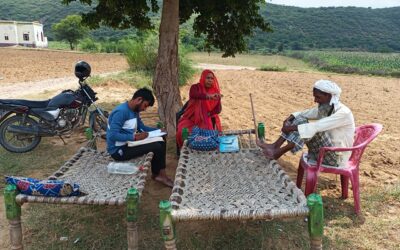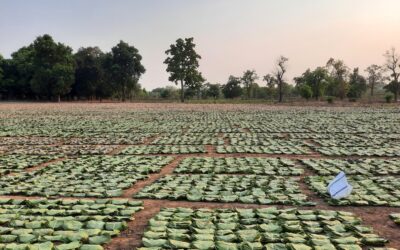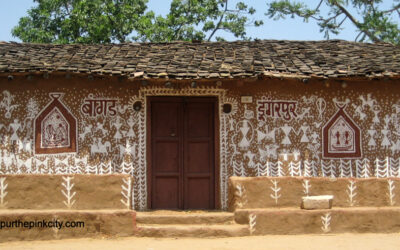Packing Bags From Kanpur
Travel is love but it becomes more fun when the journey is not pre-decided or certain. The same happened with me when I had to leave Kanpur, about which I had gotten to know only 5 minutes back and within two hours, I had already left. After I had invested a whole month with Shramik Bharti here, I was assigned to a new project in Bhadohi, near Varanasi. It required basic knowledge of natural agriculture. So, I went via “प्रेम सिंह की बग़िया” (Humane Agrarian Center) in Banda where I could learn more about traditional farming methods, techniques, and advantages to adopting it.
Natural farming is an ecological farming approach and is a holistic method in which farmers are discouraged to buy market-based inputs like chemical fertilizers, chemical pesticides, etc. used for growing plants as they affect the fertility of the soil and poison plants. Natural farming methods lead to growth of healthy soil with earthworms, natural composts and thereby, growing plants in a minimal budget.

On the journey from Kanpur to Banda, I had assumed humane agrarian center to be a big farmland where farmers grow crops and vegetables through natural methods and nothing more. I had an overly simplistic idea in my mind and with that, I was excited. But on reaching, I realized how wrong I was and felt absolutely amazed as well as ecstatic by what I saw there. It was a blueprint of how one would imagine agriculture in their dreams.
आवर्तणशील खेती
“प्रेम सिंह की बग़िया” (Humane Agrarian Center) is an agriculture training center as well as a big farmhouse spread across 4 acres where everything is well managed, sustainable, eco-friendly and of course, beautiful. Prem Singh, apart from being the founder of this center, is an organic farmer and philosopher from Banda. He strongly believes that farming has to be a self-sustaining occupation.
“If farming has to be done right, we need to become independent. Grow everything for our family and ourselves first, not for the market. Add value to the products or raw material. In this way, one can generate twice or even thrice the amount of revenue. Most importantly, respect and give back to nature, which already provides a plenty of resources to us.”
– Prem Singh
He believes in the idea of “आवर्तणशील खेती” (periodic proportionate farming) which encourages a farmer to divide his land into three parts: one-third to be used as a garden to grow fruits and crops, one-third for rearing livestock, and another one-third for growing timber. Further, this approach advocates crop rotation, organic farming, animal husbandry, food processing, improving soil fertility and seed development. It stresses on the fact that organically grown compost can be widely used by the farmer, thereby increasing the soil quality and fertility, leading to high quality yield of harvest devoid of chemicals.
Whatever a farmer needs to run his/her household, be it oil, vegetables, pulses, cereals, wood or water, it should be homegrown. After sustaining the family, the remaining surplus produce should be taken to the market. This way, a farmer will not be controlled by the demand and supply of the market. Prem Singh is aware of the limitations of self-sustaining practices and agrees that there will always be days or months when one will have to buy from the market. However, he advocates buying these items from within the community or from neighbouring villages, to ensure that the society as a whole, also prospers.
In Banda
In his “बगिया”, there are several beautiful mud houses for guests and center members. There is also a photo gallery of Mahatma Gandhi called Gandhi Ghar. On the farm, one part is used to grow crops and vegetables. In the kitchen garden grow organic vegetables to fulfil the requirements of the people living on the farm. The second part is used for growing fruits and timber. There’s Guava, Kadam, Amla and more than 50 mango trees. The third part is used for poultry, pisciculture, rearing livestock and animal husbandry. There is a pond which is used for pisciculture and also provides the base for rainwater conservation.
The idea behind this system is that agriculture is not only about ploughing, sowing and harvesting. Rather, it is a system capable of providing permanent solutions to climate change and unemployment while catering to the needs of a huge population to have quality healthy food. In this center, there is a 3 KiloWatt micro grid solar panel system for electricity on the farm, including the usage for irrigation. To cook, they have biogas plants. Everything is recycled and reused. Kitchen waste and cow dung are used to make composts and biogas. The whole system is self-sustainable.
Living My Dream For 5 Days
Staying in a mud house surrounded by mango trees felt like a dream. After a long time, I woke up really early in the morning and worked in the field no matter the weather conditions. It was like a retreat with healthy organic food and peaceful surroundings far away from the city noise. I learned many things on the farm not just by reading but by doing practically like ploughing the land, sowing vegetables, learning to make ‘शिवांश’ (Berkeley compost), ‘जीवामृत’, ‘घनामृत’, vermi-compost, and using multilayer kitchen garden methods. All these were first-time experiences for which I’ll forever be grateful to Prem Sir and Jeetendra who taught all this to me. Jeetendra is just a few years older than me and has a brilliant knowledge of agriculture. He has become a good friend of mine.
Now, with this learning, I hope I can add value to the farmers in Bhadohi.










0 Comments